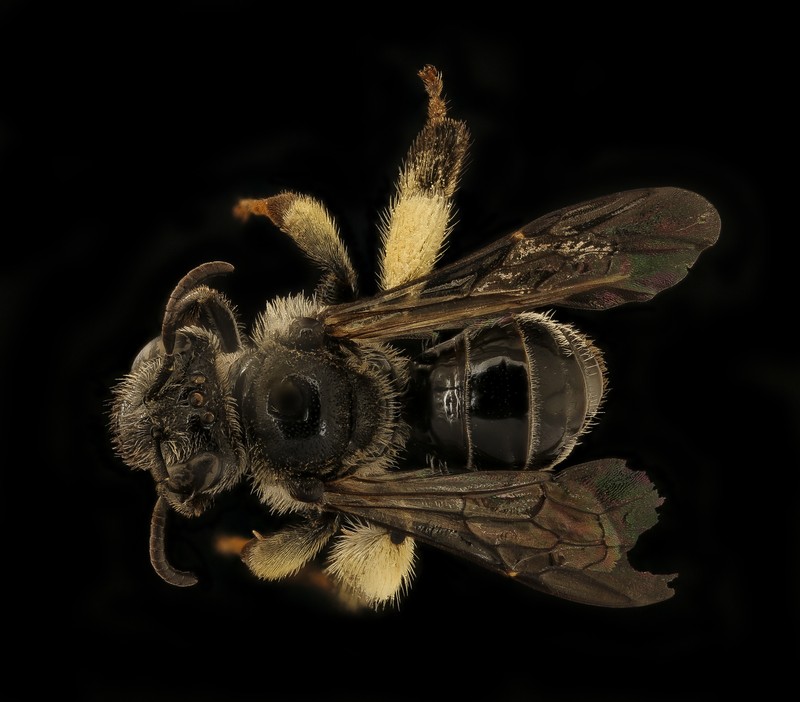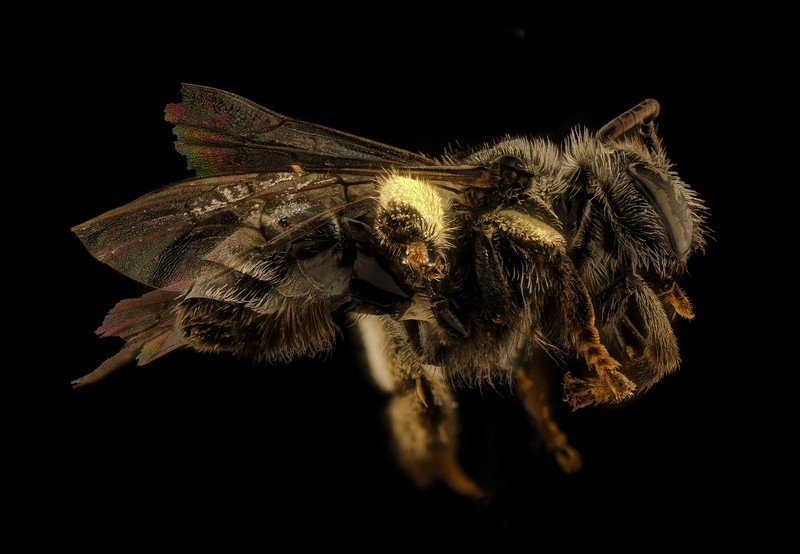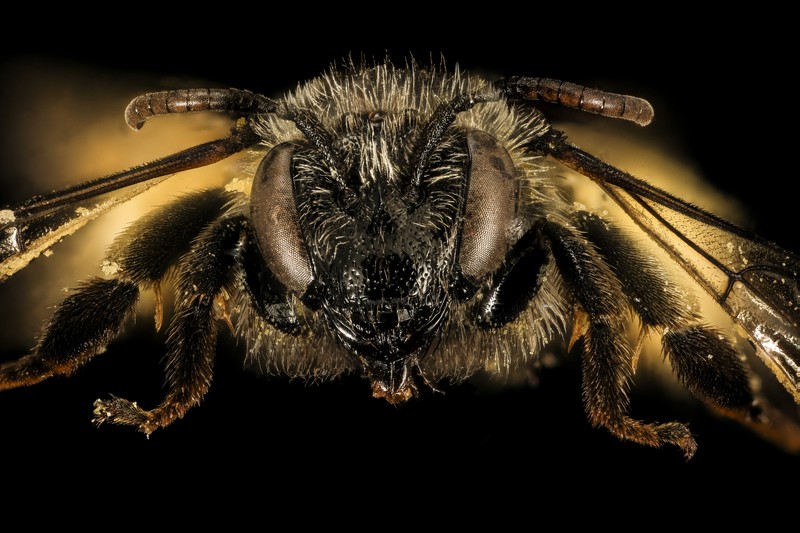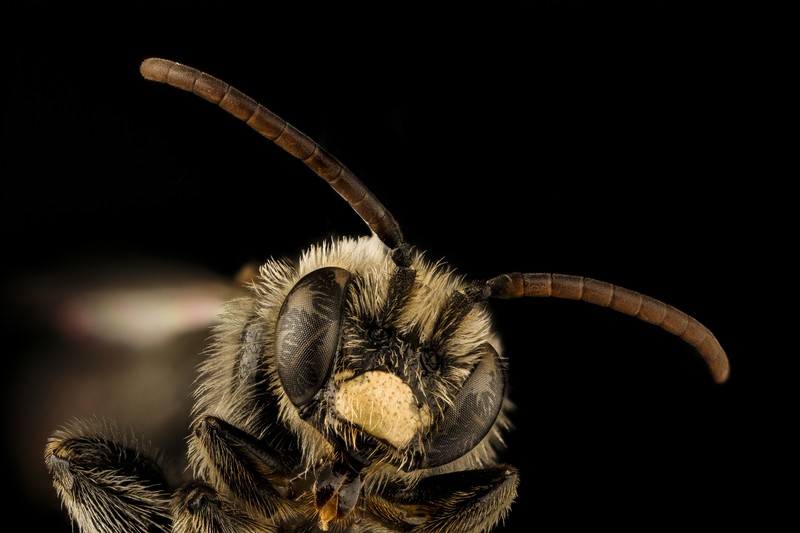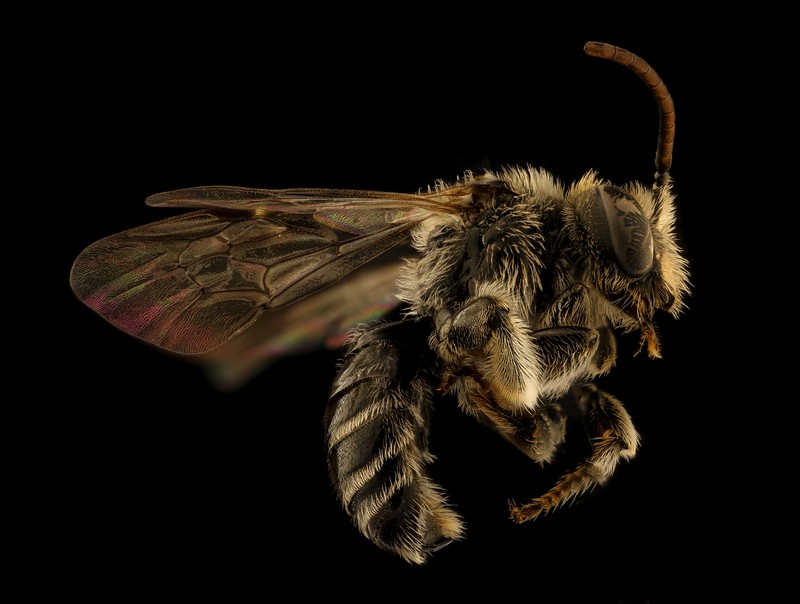Common Loosestrife Oil Bee
Macropis nuda (Provancher, 1882)
- Class
- Insecta (Insects)
- Family
- Melittidae
- State Protection
- Not Listed
Not listed or protected by New York State.
- Federal Protection
- Not Listed
- State Conservation Status Rank
- S2
Imperiled in New York - Very vulnerable to disappearing from New York due to rarity or other factors; typically 6 to 20 populations or locations in New York, very few individuals, very restricted range, few remaining acres (or miles of stream), and/or steep declines.
- Global Conservation Status Rank
- GNR
Not Ranked - Global conservation status not yet assessed.
Summary
Did you know?
Macropis nuda has an interesting mating biology. Males search for mates in areas around flowers. If a female is not interested in mating, she will reject a male with a single kick of her hind legs to dislodge the male and will keep her legs extended for several minutes to signal that she is not interested in additional advances (Cane et al. 1983).
Short-term Trends
Short-term trends are currently unknown for M. nuda.
Long-term Trends
M. nuda is declining in the Northeast (van Dyke et al. 2020). Efforts to survey native bee communities have failed to find rare species such as M. nuda in parts of its range that were previously occupied (Evans et al. 2022). There are historical (1999 and earlier) records from 15 counties; however, recent efforts (2000 and later) were only able to confirm M. nuda in four of those counties that were historically known (White et al. 2022). Recent survey efforts in New York were able to detect M. nuda in an additional three counties, not previously known (White et al. 2022). Even with the new county observations, the currently known distribution in New York is roughly half of what it was 40 years ago.
Buckner and Danforth (2022) developed habitat suitability prediction models for 2050 and 2090 and found that suitable habitat for M. nuda will be lost in the northeast under multiple climate change scenarios. In response to climate change, M. nuda and its host plant, Fringed Loosestrife (Lysimachia ciliata), are likely to track northward; however, it appears that 21-25% of suitable habitat will be lost (Buckner and Danforth 2022). Management and protection of suitable habitat in the projected suitable habitat range will be imperative to support this species in the face of climate change.
Conservation and Management
Threats
In the northeast, anthropogenic threats causing habitat loss, degradation, or phenologic mismatch threaten specialist bees and their associations (Fowler 2016b). Land use change in particular has resulted in the loss of M. nuda nesting sites. Bartomeus et al. (2013) found that native bee species richness has declined over a 140-year period and relative abundance has significantly declined for some species, including M. nuda, likely due to their specialized diet and short activity period. Additionally, climate change related habitat loss and shifting niches will have a negative impact on M. nuda populations by reducing the amount of suitable habitat available (Buckner and Danforth 2022). Kammerer et al. (2020) found that solitary bees are more sensitive to drought and warmer winters associated with climate change.
Invasive plant species likely threaten M. nuda populations. This specialist bee will nectar on flowering species other than native loosestrifes but may avoid non-native plants. One study near the Huyck Preserve in Rensselaerville, New York observed that M. nuda did not visit two invasive flowering plants, Creeping Jenny (Lysimachia nummularia) or Moneywort (L. nummularia), growing near an active nest site (Cane et al. 1983). Invasive plants can also displace natives and create monocultures reducing the floral resources available, as seen by purple loosestrife (Lythrum salicaria) invasions (Buckner and Danforth 2022). The loss of native loosestrife populations will likely result in the loss of Macropis populations (van Dyke et al. 2020).
Pesticides, in particular neonicotinoids, present threats to native bee communities (Main et al. 2020). Herbicides and fungicides appear to have a negative impact on bee fitness (Cullen et al. 2019). Pesticide exposure can result in direct mortality or cause sub-lethal effects that reduce a bee's ability to forage or learn and may decrease overall fitness (Schuhmann et al. 2022).
Conservation Strategies and Management Practices
In the northeast, there are just four species in the genus Macropis, three of which reside in New York, and all are loosestrife (Lysimachia spp.) pollen specialists. Management practices should protect intact wetlands and habitat. Most habitat restoration efforts benefit generalist bees; while creating pollinator habitat is beneficial, it is not advantageous to many specialist bees like M. nuda because pollen of other species is not nutritionally suitable for their offspring (Fowler 2016a, 2016b).
Invasive species control in wetlands may be necessary to ensure suitable habitat for M. nuda. Additional planning and specific permits are likely needed to proceed with invasive species removal and management. Prioritizing the use of native plants and avoiding the use of introduced plants will benefit this species. Including native loosestrifes, like Fringed Loosestrife (L. ciliata), in wetland restoration plantings will provide forage for M. nuda and other wetland specialists (Fowler 2016a, 2016b). Fringed Loosestrife seeds and transplants are commercially available (van Dyke et al. 2020). This herbaceous plant grows in shrublands, woods, and along streambanks throughout New York and blooms between June through September (van Dyke et al. 2020). Including additional floral resources will also benefit M. nuda populations. Even though it is a pollen specialist, both males and females’ nectar on a variety of plants. Spreading dogbane (Apocynum androsaemifolium) appears to be a major nectar source for M. nuda in New York (Buckner and Danforth 2022) and elsewhere within its range (Wood et al. 2019).
Potentially of highest importance when managing for M. nuda is to avoid land management that may reduce nesting habitat for this species. While plants in the Lysimachia genus appear to be stable and can adapt to altered environments, suitable nesting sites for M. nuda continue to be destroyed (Simpson and Neff 1983). Therefore, protecting against the reduction or removal of riparian habitats from erosion (e.g., recreational use) or compaction (e.g., development) will benefit this species (Buckner and Danforth 2022).
Research Needs
Additional research on habitat requirements, threats, implications of climate change, and the effects of pesticide use is needed for M. nuda. Research focused dispersal abilities is especially relevant to better understand if this species can keep up with its expected northern range shift in response to climate change (Buckner and Danforth 2022). Identifying what types of specific management strategies benefit M. nuda populations will also be important because populations may respond differently depending on the type of management. One recent trapping effort found M. nuda solely in undisturbed areas and absent from burned or grazed areas (Miller 2021).
Habitat
Habitat
In New York, M. nuda could potentially occur where its host plant is found in shrublands, woods, and along streambanks (van Dyke et al. 2020). M. nuda is a specialist (i.e., monolege) bee of loosestrifes (Myrsinaceae: Lysimachia) (Fowler 2016a, 2016b). Intact wetland habitat where native loosestrifes occur is critical foraging habitat for this species. M. nuda is known from prairie fens, wet-mesic prairies (Rowe et al. 2022), ephemeral wetlands, ditches, and along waterways (van Dyke et al. 2020).
Macropis nuda is a pollen and oil specialist of Fringed Loosestrife (Lysimachia ciliata) which produces copious amounts of pollen and secretes floral oils instead of nectar. Females have been observed collecting nectar from two different flower species before provisioning nests with the oil and pollen of Fringed Loosestrife (L. ciliata) (Cane et al. 1983). Floral resources M. nuda has been observed nectaring on include: Spreading dogbane (Apocynum androsaemifolium) (Buckner and Danforth 2022), Bristly Sarsaparilla (Aralia hispida), Blue Lettuce (Lactuca pulchella), blueberry (Vaccinium sp.), geranium (Geranium sp.), brambles (Rubus sp.), New Jersey Tea (Ceanothus americanus) (Michez and Patiny 2005), Indian Hemp (A. cannabinum) (Wood et al. 2019), buttercup (Ranunculus sp.), and Smooth Sumac (Rhus glabra) (Cane 1983).
M. nuda is a ground nesting bee. Nests are typically aggregated on gently sloping ground and are shallow, typically within 6.5 mm of the surface (Cane et al. 1983, Rozen and Jacobson 1980). Nest sites have been observed in sandy-loam soil in partially shaded areas; however, nest sites appear to be variable (Cane et al. 1983).
Associated Ecological Communities
- Deep emergent marsh*
(guide)
A marsh community flooded by waters that are not subject to violent wave action. Water depths can range from 6 in to 6.6 ft (15 cm to 2 m). Water levels may fluctuate seasonally, but the substrate is rarely dry, and there is usually standing water in the fall.
- Medium fen*
(guide)
A wetland fed by water from springs and seeps. These waters are slightly acidic (pH values generally range from 4.5 to 6.5) and contain some dissolved minerals. Plant remains in these fens do not decompose rapidly and thus the plants in these fens usually grow on older, undecomposed plant parts of woody material, grasses, and mosses.
- Northern white cedar swamp*
(guide)
A swamp that occurs on organic soils in cool, poorly drained depressions in central and northern New York, and along lakes and streams in the northern half of the state. These swamps are often spring-fed with continually saturated soils. Soils are often rich in calcium. The characteristic tree is northern white cedar, which makes up more than 30% of the canopy cover.
- Shallow emergent marsh*
(guide)
A marsh meadow community that occurs on soils that are permanently saturated and seasonally flooded. This marsh is better drained than a deep emergent marsh; water depths may range from 6 in to 3.3 ft (15 cm to 1 m) during flood stages, but the water level usually drops by mid to late summer and the soil is exposed during an average year.
- Silver maple-ash swamp
(guide)
A hardwood basin swamp that typically occurs in poorly-drained depressions or along the borders of large lakes, and less frequently in poorly drained soils along rivers. These sites are characterized by uniformly wet conditions with minimal seasonal fluctuations in water levels. The dominant trees are usually silver maple and green ash.
* probable association but not confirmed.
Range
New York State Distribution
M. nuda is currently extant in seven counties in New York. The Empire State Native Pollinator Survey effort (2017-2020) detected M. nuda in three new counties (Clinton, Oswego, Delaware counties) and verified an additional four counties with partner data (Jefferson, Lewis, Warren, and Albany counties) (White et al. 2022). It was historically (1999 and earlier) known from an additional 11 counties in New York (Rockland, Westchester, Bronx, Kings, Nassau, Herkimer, Hamilton, Essex, Rensselaer, Cayuga, and Tompkins counties) but was not observed during the recent multi-year survey effort (White et al. 2022). When looking at county level occurrences, this species is absent most noticeably from southeastern New York.
Global Distribution
M. nuda<\i> appears to be a northern species. The range for M. nuda<\i> includes Michigan, Colorado, Maine (Michez and Patiny 2005), Connecticut, Idaho, Massachusetts, Minnesota, Montana, New Jersey, New York, Pennsylvania, Vermont, and Wyoming in the U.S. and British Columbia, Manitoba, New Brunswick, Nova Scotia, Ontario, Quebec, and Saskatchewan provinces in Canada (DiscoverLife 2023, NatureServe 2021).
Best Places to See
- Lake Myosotis (Albany County)
Identification Comments
Identifying Characteristics
The Macropis genus is comprised of three subgenera: Macropis, Sinomacropis, and Paramacropis and M. nuda is in the Macropis subgenus (Michez and Patiny 2005). M. nuda is a small dark bee between 7-9 mm (Michez and Patiny 2005). Males have yellow coloration on their face (i.e., clypeus); whereas females have a dark face and also have dense hair on their legs (i.e., scopa) (Michez and Patiny 2005). The light-colored hairs (i.e., scopae) present under the females’ abdomens and on legs are specially adapted to hold loosestrife pollen and oil (Cane 1983).
This oil-collecting bee can be challenging to identify in the field and may require the help of an expert. Specific identifying characteristics and a key can be found in the 2005 paper “World revision of the oil-collecting bee genus Macropis Panzer 1809 (Hymenoptera: Apoidea: Melittidae) with a description of a new species from Laos” by Michez and Patiny.
Best Life Stage for Proper Identification
Adult.
Behavior
Females collect pollen and oil by patting the underside of their abdomens (i.e., metasoma) on loosestrife flowers (Portman et al. 2019). They use the oils to waterproof nest cell walls and for larval nutrition. Females provision their nests with an oil-pollen loaf and lay their eggs on top of it within the cell (Rozen and Jacobson 1980). Their cells are lined with a greenish-yellow waxy waterproofing material (Cane et al. 1983, Rozen and Jacobson 1980). After the egg hatches, the larvae consume their provisions in just a few weeks and spin a cocoon to pupate and overwinter in.
Best Time to See
In the Northeast, adult specialist bees are inactive in the winter months and typically overwinter in nests as pre-pupae (Fowler 2016b). In New York, M. nuda has been observed as early as June 9th through the beginning of August, and the best time to see M. nuda is in July (White et al. 2022). This species may be active through September in other parts of its range (Discover Life 2023). Adults, similar to other bees, are active on sunny days and can typically be seen from 10 am to 6 pm on sunny, calm days. Both males and females have been observed sleeping on, upside down, and in the flowers near nesting aggregations (Rozen and Jacobson 1980).
- Present
- Active
- Reproducing
The time of year you would expect to find Common Loosestrife Oil Bee present, active, and reproducing in New York.
Similar Species
- Fringed Loosestrife Oil-collecting Bee (Macropis ciliata)
Hind leg with "two tooth-like distal processes" and reduced apical spurs, whereas M. nuda lacks teeth on hind leg and "both apical spurs normally developed" (Michez and Patiny 2005).
- Patellar Oil-collecting Bee (Macropis patellata)
Hind leg with "one tooth-like distal process" and reduced outer spur, whereas M. nuda lacks teeth on hind leg and "both apical spurs normally developed" (Michez and Patiny 2005).
Common Loosestrife Oil Bee Images
Taxonomy
Common Loosestrife Oil Bee
Macropis nuda (Provancher, 1882)
- Kingdom Animalia
- Phylum Arthropoda
(Mandibulates)
- Class Insecta
(Insects)
- Order Hymenoptera
(Bees, Wasps, Ants, Sawflies)
- Family Melittidae
- Order Hymenoptera
(Bees, Wasps, Ants, Sawflies)
- Class Insecta
(Insects)
- Phylum Arthropoda
(Mandibulates)
Additional Resources
References
Bartomeus, I., J. S. Ascher, J. Gibbs, B. N. Danforth, D. L. Wagner, S. M. Hedtke, and R. Winfree. 2013. Historical changes in northeastern US bee pollinators related to shared ecological traits. Proceedings of the National Academy of Sciences 110:4656–4660.
Buckner, M., and B. Danforth. 2022. Climate-driven range shifts of a rare specialist bee, Macropis nuda (Melittidae), and its host plant, Lysimachia ciliata (Primulaceae). Global Ecology and Conservation e02180:1–12.
Cane, J. H., G. C. Eickwort, F. R. Wesley, and J. Spielholz. 1983. Foraging, Grooming and Mate-seeking Behaviors of Macropis nuda (Hymenoptera, Melittidae) and Use of Lysimachia ciliata (Primulaceae) Oils in Larval Provisions and Cell Linings. The American Midland Naturalist 110:257–264. University of Notre Dame.
Cullen, M.G., L.J. Thompson, J.C. Carolan, J.C. Stout, D.A. Stanley. 2019. Fungicides, herbicides and bees: A systematic review of existing research and methods. PLOS One. doi: https://doi.org/10.1371/journal.pone.0225743
Discover Life. 2023. Macropis nuda<\i> (Provancher, 1882). [Online]. Available at: https://www.discoverlife.org/20/q?search=Macropis+nuda
Evans, E., J. Ascher, D. P. Cariveau, and M. Spivak. 2022. A Century of Change for Prairie Bees and Their Floral Associations. Prairie Naturalist:78–102.
Fowler, J. 2016a. Specialist Bees of the Northeast: Host Plants and Habitat Conservation. Northeastern Naturalist 23:305–320. Eagle Hill Institute.
Fowler, J. 2016b. Specialist Bees of the Mid-Atlantic: Host Plants and Habitat Conservation 6:1–40.
Fowler, J., and S. Droege. 2020. Pollen Specialist Bees of the Eastern United States [Online]. Available: https://jarrodfowler.com/specialist_bees.html.
Kammerer, M., S.C. Goslee, M.R. Douglas, J.F. Tooker, and C.M. Grozinger. 2020. Wild bees as winners and losers: Relative impacts of landscape composition, quality, and climate. Global Change Biology. 27:1250-1265.
Main, A.R., E.B. Webb, K.W. Goyne, and D. Mengel. 2020. Reduced species richness of native bees in field margins associated with neonicotinoid concentrations in non-target soils. Agriculture, Ecosystems, and Environment. 287: 106693. doi: https://doi.org/10.1016/j.agee.2019.106693
Michez, D., and S. Patiny. 2005. World revision of the oil-collecting bee genus Macropis Panzer 1809 (Hymenoptera: Apoidea: Melittidae) with a description of a new species from Laos. Annales de la Société entomologique de France (N.S.) 41:15–28.
Miller, R. 2021. Management and Landscape Effects on Beneficial Tallgrass Prairie Insects - A Study of Bees and Beetles. Master of Science, University of Manitoba.
NatureServe. 2021. Macropis nuda<\i> Common Loosestrife Oil Bee [Online]. Available: https://explorer.natureserve.org/Taxon/ELEMENT_GLOBAL.2.928341/Macropis_nuda.
New York Natural Heritage Program. 2024. New York Natural Heritage Program Databases. Albany, NY.
Portman, Z. M., M. C. Orr, and T. Griswold. 2019. A review and updated classification of pollen gathering behavior in bees (Hymenoptera, Apoidea). Journal of Hymenoptera Research 71.
Rowe, L., D. Cuthrell, and Z. Portman. 2022. Baseline wild bee surveys in Michigan Lakeplain Prairie and Prairie Fen natural communities. MNFI Report, Great Lakes Restoration Initiative, Pollinator Task Force. 1–24 pages.
Rozen, J. G., and N. R. Jacobson. 1980. Biology and immature stages of Macropis nuda, including comparisons to related bees (Apoidea, Melittidae). American Museum novitates¿; no. 2702. New York, N.Y.¿: American Museum of Natural History.
Schuhmann, A., A.P. Schmid, S. Manzer, J. Schulte, and R. Scheiner. 2022. Interaction of Insecticides and Fungicides in Bees. Front. Insect Sci. 1:808335. doi:10.3389/finsc.2021.808335
Simpson, B. B., and J. L. Neff. 1983. Floral Biology and Floral Rewards of Lysimachia (Primulaceae). The American Midland Naturalist 110:249–256. University of Notre Dame.
White, Erin L., Matthew D. Schlesinger, and Timothy G. Howard. 2022. The Empire State Native Pollinator Survey (2017-2021). New York Natural Heritage Program. Albany, NY.
Wood, T., M. Killewald, K. Graham, J. Gibbs, and R. Isaacs. 2019. Epeoloides pilosulus (Cresson) Rediscovered in Michigan, with Notes on the Distribution and Status of its Macropis hosts. The Great Lakes Entomologist 52:1–5.
van Dyke, M., K. Boys, R. Parker, R. Wesley, and B. Danforth. 2020. Creating a pollinator garden for native specialist bees of New York and the Northeast. Pollinator Pathway. 1–33 pages.
Links
About This Guide
This guide was authored by: Katie G. Hietala-Henschell
Information for this guide was last updated on: October 10, 2023
Please cite this page as:
New York Natural Heritage Program. 2024.
Online Conservation Guide for
Macropis nuda.
Available from: https://guides.nynhp.org/common-loosestrife-oil-bee/.
Accessed April 27, 2024.
